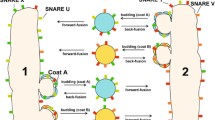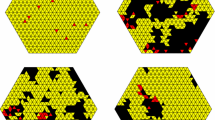Abstract
Philosophers of science have recently focused on the scientific activity of modeling phenomena, and explicated several of its properties, as well as the activities embedded into it. A first approach to modeling has been elaborated in terms of representing a target system: yet other epistemic functions, such as producing data or detecting phenomena, are at least as relevant. Additional useful distinctions have emerged, such as the one between phenomenological and mechanistic models. In biological sciences, besides mathematical models, models now come in three forms: in vivo, in vitro and in silico. Each has been investigated separately, and many specific problems they raised have been laid out. Another relevant distinction is disciplinary: do models differ in significant ways according to the discipline involved—medicine or biology, evolutionary biology or earth science? Focusing on either this threefold distinction or the disciplinary boundaries reveals that they might not be sufficient from a philosophical perspective. On the contrary, focusing on the interaction between these various kinds of models, some interesting forms of explanation come to the fore, as is exemplified by the papers included in this issue. On the other hand, a focus on the use of models, rather than on their content, shows that the distinction between biological and medical models is theoretically sound.
Similar content being viewed by others
References
Belzung, C., & Lemoine, M. (2011). Criteria of validity for animal models of psychiatric disorders: focus on anxiety disorders and depression. Biology of Mood and Anxiety Disorders, 1(1), 1–9.
Bernard, C. (1865). Introduction à l’étude de la médecine expérimentale. Paris: Baillière.
Brody, F., & Vamos, T. (Eds.). (1995). The neumann compendium. Boston: World Scientific.
Burian, R. (1993). How the choice of experimental organism matters: epistemological reflections on an aspect of biological practice. Journal of the History of Biology, 26(2), 351–367.
de Ménuret Chambaud, J. J. (1765). Observateur. In D. Diderot & J. d’Alembert (Eds.), Encyclopédie (Vol. 11, pp. 310–313). Paris: Briasson.
Frigg, R. (2010). Models and fiction. Synthese, 172(2), 251–268.
Gayon, J. (2006). Les organismes modèles en biologie et en médecine. In G. Gachelin (Ed.), Les organismes modèles dans la recherché médicale (pp. 9–43). Paris: PUF.
Giere, R. (1988). Explaining science: A cognitive approach. Chicago: University of Chicago Press.
Giere, R. (2006). Scientific perspectivism. Chicago: University of Chicago Press.
Goldstein, K. (1939). The organism: A holistic approach to biology derived from pathological data in man, New York: American Book Company (Translation of Aufbau des Organismus. Einführung in die Biologie unter besonderer Berücksichtigung der Erfahrungen am kranken Menschen), Den Haag: Nijhoff, 1934.
Grune-Yanoff, T., & Weirich, P. (2010). Philosophy of simulation. Simulation and Gaming, 41(1), 1–31.
Hempel, C. G. (1965). Aspects of scientific explanation and other essays in the philosophy of science. New York: Free Press.
LaFollette, H., & Shanks, N. (1995). Two models of models in biomedical research. The Philosophical Quarterly, 45(179), 141–160.
Leonelli, S., & Ankeny, R. (2012). Re-thinking organisms: The epistemic impact of databases on model organism biology. Studies in the History and Philosophy of the Biological and Biomedical Sciences, 43, 29–36.
Levins, R. (1966). The strategy of model building in population biology. American Scientist, 54, 421–431.
Matthewson, J., & Weisberg, M. (2009). The structure of trade-offs in model building. Synthese, 170(1), 169–190.
Maugeri, P., & Blasimme, A. (2011). Humanised models of cancer in molecular medicine: the experimental control of disanalogy. History and Philosophy of the Life Sciences, 33(1), 603–622.
Maynard-Smith, J. (1982). Evolution and the theory of games. New York: Oxford University Press.
Mitchell, S. (2003). Biological complexity and integrative pluralism. Cambridge: Cambridge University Press.
Morgan, M., & Morrison, M. (Eds.). (1999). Models as mediators. Perspectives on natural and social science. Cambridge: Cambridge University Press.
Morrison, M. (2000). Unifying scientific theories. Cambridge: Cambridge University Press.
Nersessian, N. (2008). Creating scientific concepts. Cambridge: MIT Press.
O’Malley, M., & Soyer, O. (2011). The roles of integration in molecular systems biology. Studies in History and Philosophy of Biological and Biomedical Sciences, 43, 58–68.
Schaffner, K. (1993). Discovery and explanation in biology and medicine. Chicago: The University of Chicago Press.
Steel, D. (2008). Across the boundaries: Extrapolation in biology and social science. New York: Oxford University Press.
Strevens, M. (2009). Depth. New York: Oxford University Press.
Suppe, F. (1989). The semantic view of theories and scientific realism. Chicago: University of Illinois Press.
Suppes, P. (1960). A comparison of the meaning and uses of models in mathematics and the empirical sciences. Synthese, 12, 287–301.
van Fraassen, B. C. (1980). The scientific image. Oxford: Oxford University Press.
Weber, M. (2005). Philosophy of experimental biology. Cambridge: Cambridge University Press.
Wimsatt, W. (1987). False Models as Means to Truer Theories. In N. Nitecki & A. Hoffman (Eds.), Neutral models in biology (pp. 23–55). Oxford: Oxford University Press.
Winsberg, E. (2010). Science in the age of computer simulation. Chicago: The University of Chicago Press.
Woodward, J. (2003). Making things happen. New York: Oxford University Press.
Author information
Authors and Affiliations
Corresponding author
Rights and permissions
About this article
Cite this article
Huneman, P., Lemoine, M. Introduction: the plurality of modeling. HPLS 36, 5–15 (2014). https://doi.org/10.1007/s40656-014-0002-5
Received:
Accepted:
Published:
Issue Date:
DOI: https://doi.org/10.1007/s40656-014-0002-5




